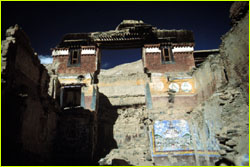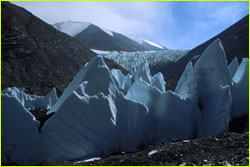
|
 |
 |
by Jeanne-Marie Gilbert On the north side of the Himalaya sits the partially reconstructed Tibetan Buddhist monastery of Rongbuk, once the largest monastic center in the region. Rongbuk is the power place through which all seeking the highest peak via the North Face must pass. It is the sacred threshold to Mount Everest, with the most dramatic views in the world. One of the first British explorers to see it, John Noel, described it: "Some colossal architect, who built with peaks and valleys, seemed here to have wrought a dramatic prodigy—a hall of grandeur that led to the mountain." Often shrouded in clouds and mist, the great peak was alternately described as "a preposterous triangular lump" (by Mallory) and "a glittering spire of rock fluted with snow" (by Odell), with "an imposing head of granite and ice," (Noel) and it looms large over the Rongbuk glacier, shining white at its feet. The Rongbuk monastery, situated half-way up the mile-wide, 20-mile long valley at 16,500 feet, is accessible today by vehicle over an obscure, rough track that crosses frozen streams and deep dry washes. In the days of Mallory and Irvine, it took a five-week walk from Darjeeling, in the Indian foothills of the Himalaya, to arrive at this spot. One gradually gains altitude on the high Tibetan plain and, on crossing the last pass, one's entire view is filled with a panorama of the mythically charged horizon: Shishipangma, Mount Everest, and Cho Oyu are among the great peaks that lie ahead.
At Rongbuk, there is a beautiful, large, round chorten, a reliquary with religious significance embedded in its terraced structure and crown of emblems of the sun and moon, symbolizing the light of Buddha's teaching. The chorten dramatically marks this last human dwelling place before one heads up the stark valley to Base Camp. In previous times, the Rongbuk Monastery became very active with the teachings at certain times of the year. It was a site of special pilgrimage during the annual ceremonies with masked dancers. Throngs of the faithful would come from far and wide—some from Nepal and Mongolia—and sit on every level of all the many-tiered flat roofs of the monastery to watch the masked dancers in the great open courtyard. Cymbals clanged amid the ceaselessly overlapping thunder of the long Tibetan trumpets played in relay to accompany the monk dancers in their ritual. These ceremonies were shared with the satellite monasteries across the Himalaya also founded by the Rongbuk Lama. The ceremonies survive to this day, notably at the Sherpa monastery at Tengboche. Rongbuk's vast treasury of books and costumes, which had been taken for safekeeping to Tengboche, were tragically lost in a 1989 fire.
Photos: (1, 2) Peter Tyson; (3) Liesl Clark. Lost on Everest | High Exposure | Climb | History & Culture | Earth, Wind, & Ice E-mail | Previous Expeditions | Resources | Site Map | Everest Home Editor's Picks | Previous Sites | Join Us/E-mail | TV/Web Schedule About NOVA | Teachers | Site Map | Shop | Jobs | Search | To print PBS Online | NOVA Online | WGBH © | Updated November 2000 |
 Rongbuk Monastery and its great Chorten precede the
Abode of Snows.
Rongbuk Monastery and its great Chorten precede the
Abode of Snows.
 Ruins of the Lhakhang of Rongbuk
Ruins of the Lhakhang of Rongbuk
 Life reduced to the bare elements near the terminus
of the Rongbuk glacier.
Life reduced to the bare elements near the terminus
of the Rongbuk glacier.